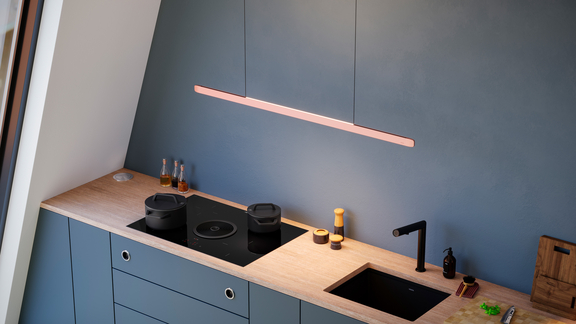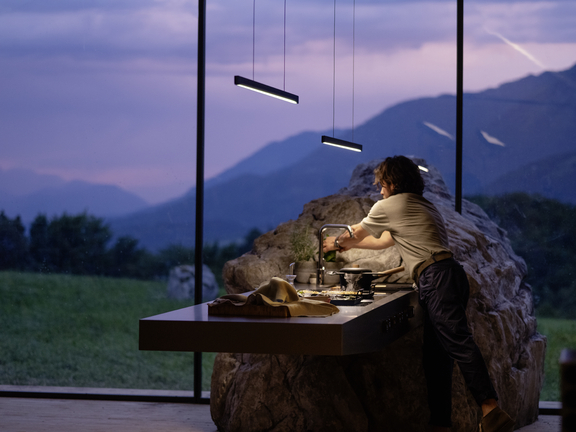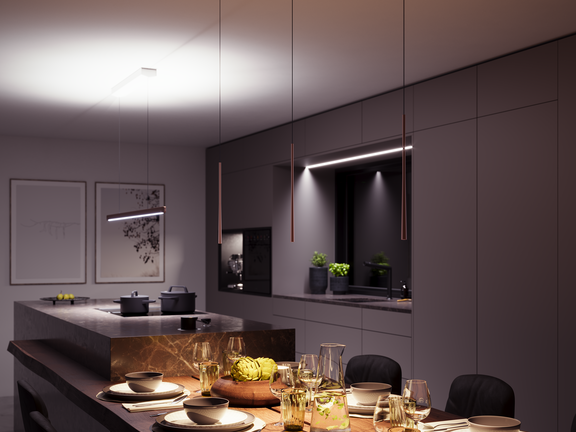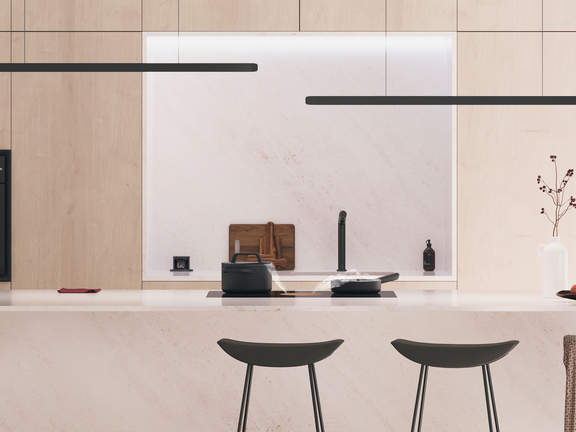

Whether naturally from outside or using artificial light sources: Successful lighting in the kitchen requires careful planning and creative ideas.
What do you need to pay attention to and how do you create a lighting concept that turns the room into a real feel-good place? We show you what is important when it comes to kitchen lighting.
Light sources have a functional, emotional and aesthetic significance - even in the kitchen. This applies to ambient lighting, such as dimmable ceiling spotlights, as well as accent lighting.

In the form of functional lighting, good lighting in the kitchen is a prerequisite for relaxed and concentrated work and cooking. Above all, it is indispensable when you are handling knives and other sharp tools.
In an integrated dining area, lighting is an emotional element that creates a cosy atmosphere. There, an atmospheric, discreet lighting solution is more important than one that illuminates every detail.
If the kitchen has an adjoining dining area, the dining table lighting also plays an important role.

As a rule, a pendant luminaire provides direct light. This fulfils two tasks: Firstly, it serves as functional light during meals. Secondly, it accentuates the dining or kitchen table within the room. Pendant luminaires can also be used in the kitchen as lighting for worktops without wall units - including cooking islands.
In addition to artificial light sources, natural lighting is also used in the kitchen. It is advisable to take this into account at the planning stage. The incidence of light through the window (as well as the view) can be important when arranging the work area, for example.
It is all too easy to get lost in the details of kitchen lighting, such as the design of the lights and lamps. These are important - but the first step is to define different kitchen areas with different lighting requirements. These include:

The second step is to determine which and how many light sources you need and how bright they should be. In addition, there is the basic lighting, which ideally illuminates all zones relatively evenly. Once the basic lighting concept has been defined, you can select suitable kitchen lights and light sources.
The lighting in the kitchen has similarities with that in other rooms, but also some special features.
To work in a pleasant, relaxed atmosphere, an interplay of basic, functional and accent lighting is essential. This can be achieved by using direct and indirect lighting in the kitchen as well as different light colours.
Functional worktop lighting should generally be neutral to cold white. This corresponds to a colour temperature ranging from 3300 to 5300 K (kelvin). For homely accents, for instance, in the dining area, and the basic lighting, warm white light at 2700 to 3000 K is a great option.
This depends on the individual circumstances. What’s important is to create even lighting in the kitchen with no bothersome shadows and with sufficient brightness, especially over work surfaces.
To illuminate a simple kitchen or cooking island, neutral to cold white light at 3300 to 5300 K (kelvin) comes into play. If there is an adjoining bar counter or work surface that is used as a dining area, warm white light at 2700 to 3000 K is recommended.
If you use ceiling spotlights as basic lighting, to guarantee even lighting they should not be too far apart. What’s more, it is best to space them out so that the light beam falls about three-quarters of the way up the wall. The exact distances depend on the beam angle of the spotlights.
For basic lighting, the individual spotlight output depends on the number of spotlights and the size of the room. In general, basic lighting at 300 lm (lumen) per square metre is recommended in the kitchen. Example: if the kitchen measures 15 m2, the basic lighting should be 4500 lm. If there are nine LED spotlights on the ceiling, each spotlight should generate 500 lm – this corresponds to around 5 W (watts).
For basic lighting, a light intensity of 300 lm (lumen) per square metre is recommended. To illuminate kitchen work surfaces, 500 lm per square metre is a reasonable amount.